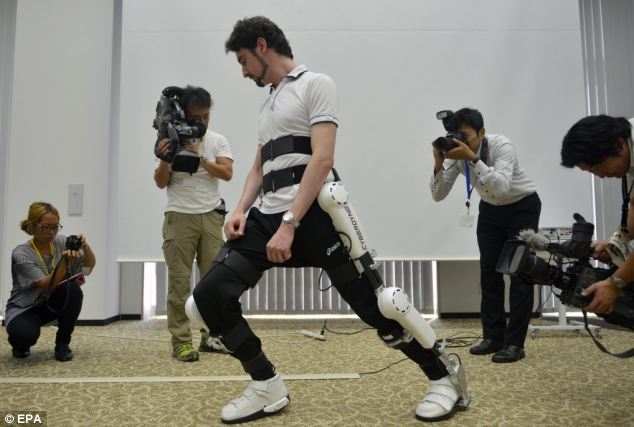The Hybrid Assisted Limb (HAL) robotic suit has passed German safety tests, increasingly the chances of it being sold in other parts of Europe.
A robotic suit that is worn as an exoskeleton and can be used to help disabled people walk again has received an EC certificate from the German safety monitoring agency.
The approval means that the Robot Suit HAL, designed by Japanese robotics firm Cyberdene, has passed the required safety tests, paving the way for the suit to be sold in other parts of Europe, including the UK.
HAL, which stands for Hybrid Assisted Limb, responds to biosignals detected on the wearer’s skin that are sent to the muscles which in turn makes the robotic limbs move.

A robotic exoskeleton used to help disabled people walk has been approved for sale in Germany. This means the Japanese Robot Suit HAL, pictured, could soon be sold in other parts of Europe including the UK


Japanese robotics firm Cyberdyne’s CEO Yoshiyuki Sankai, pictured right, presents the medical Robot Suit HAL as demonstrated, left and far right, by a Cyberdyne employee. There are two types of HAL system. The HAL 3 system, pictured, is a leg-only device, while the full-body HAL 5 additionally works with arms and torsos
THE HAL-5 SPECIFICATIONS
Height: 1.6m
Weight: Full Body Type approximately 23kg, Lower body approximately 15kg
Power: Charged battery (AC100V)
Continuous operating time: 2 hours 40 minutes
Motions: Daily activities including standing up from a chair, walking, climbing up and down stairs, holding and lifting heavy objects.
Cyberdyne and Tsukuba University began hospital trials of the HAL suit in 2012 in Japan.
By October 2012 HAL suits were being used by 130 different medical institutions across the country.
In February this year, the HAL system became the first powered exoskeleton to receive global safety certification and it has now received a EC Certificate of Conformity in Germany.
This means it has passed the German safety standards of the TUV Rhineland agency and is allowed to be sold in the country.
The exoskeleton was demonstrated during a press conference to celebrate the news at the company headquarters in Tsukuba, north-east of Tokyo, Ibaraki prefecture, Japan.
It has been designed to ‘support and expand the physical capabilities of its users, particularly people with physical disabilities.’
There are two types of HAL systems: HAL 3 provides leg function, while HAL 5 is a full-body exoskeleton for the arms, legs, and torso.
HAL 5 can help the wearer to lift and carry about five times as much weight as he or she could lift and carry unaided before.

Daily activities that the HAL system can help disabled people do include standing up from a chair, walking, climbing up and down stairs, pictured, and holding or lifting heavy objects

A Cyberdyne employee demonstrates the medical Robot Suit HAL during a press event at the company headquarters in Tsukuba, north-east of Tokyo after the suit received an EC certificate from German safety monitoring agency TUV Rhineland

The HAL system detects biosignals on the surface of a wearer’s skin. Based on these signals HAL then moves the robotic joint in time with the wearer’s muscle movement
Robot Suit HAL is a ‘cyborg-type robot’ that can be used to replace limb function or expand and improve a person’s physical capability and wellbeing.
When a person attempts to move, nerve signals are sent from the brain to the muscles through motoneurons.
This moves the musculoskeletal system as a consequence.
Weak biosignals can be detected on the surface of the skin and HAL catches these signals through a sensor attached on the skin of the wearer.
Based on the signals obtained, the power unit is then controlled to move the joint in time with the wearer’s muscle movement.
Cyberdene calls this a ‘voluntary control system’ that interprets the wearer’s intention to move, using the biosignals, and registers these in advance of the actual movement.
HAL additionally comes with a ‘robotic autonomous control system’ that provides human-like movement based on a robotic system which works with the ‘autonomous control system’.
This has been designed to make the movements as natural as possible.
Cyberdene claims HAL is the world’s first cyborg-type robot controlled by this unique Hybrid System.
The company want the device to be used in various fields such as rehabilitation support and physical training support in medical field, Activities of Daily Living (ADL) support for disabled people, heavy labour support in factories and rescue support at disaster sites, as well as in the entertainment industry.

































Leave a Comment
You must be logged in to post a comment.